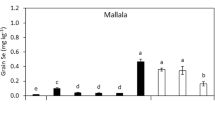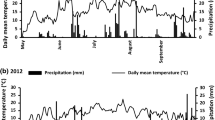Abstract
Wheat, despite its relatively low selenium (Se) concentration in the UK, is still an important dietary Se source and its biofortification by use of Se fertiliser may be an efficient means to increase the relatively low Se status of the population. We need to know more about the fate of Se applied to the soil and how to ensure the efficiency of Se application, and the three studies reported in this issue of Plant and Soil are timely and informative. Selenium in soil, both globally and locally, is notoriously variable; however, the soils in these studies yielded wheat grain Se concentrations in the narrow range of 16–44 ng/g. The low plant Se levels reported here are not surprising, given that selenite is the dominant Se form in these soils. A regression equation (which used total and extractable Se and extractable S as variables) explained a high proportion of the variance in grain Se concentration. Sulphur application (a common practice on UK wheat growing soils) had variable effects on grain Se concentration, depending on soil S status, pH and possibly other factors. A fertiliser methodology study investigated ways to optimise Se application for the purpose of biofortification. It was calculated that an application of a modest 10 g Se/ha as selenate would increase the grain Se concentration of UK wheat from around 30 ng/g to 300 ng/g. The national Se fertiliser program in Finland shows that this increase would have a large effect on population Se status. However, Se recovery in grain at this application rate is only 14%, and it can be argued that large-scale agronomic biofortification of cereals with Se would be somewhat wasteful of a relatively scarce trace element. Selenium’s effects and interactions in soil, plants, animals and humans are complex and often surprising and will keep researchers busy well into the future.
Similar content being viewed by others
References
Adams ML, Lombi E, Zhou FJ, McGrath SP (2002) Evidence of low selenium concentrations in UK bread-making wheat grain. J Sci Food Agric 82:1160–1165
Akbaraly NT, Arnaud J, Hininger-Favier I, Gourlet V, Roussel AM, Berr C (2005) Selenium and mortality in the elderly: results from the EVA study. Clin Chem 51(11):2117–2123
Bates CJ, Thane CW, Prentice A, Delves HT (2002) Selenium status and its correlates in a British national diet and nutrition survey: people aged 65 years and over. J Trace Elem Med Biol 16(1):1–8
Broadley MR, White PJ, Bryson RJ, Meacham MC, Bowen HC, Johnson SE, Hawkesford MJ, McGrath SP, Zhao F-J, Breward N, Harriman M, Tucker M (2006) Biofortification of UK food crops with selenium. Proc Nutr Soc 65:169–181
Broome CS, McArdle F, Kyle JA, Andrews IF, Lowe NM, Hart CA, Arthur JR, Jackson MJ (2004) An increase in selenium intake improves immune function and poliovirus handling in adults with marginal selenium status. Am J Clin Nutr 80(1):154–162
Bryszewska MA, Ambroziak W, Diowksz A, Baxter MJ, Langford NJ, Lewis DJ (2005) Changes in the chemical form of Se observed during the manufacture of a Se-enriched sour-dough bread for use in a human nutrition study. Food Addit Contam 22:135–140
Combs GF (2001) Selenium in global food systems. Brit J Nutr 85:517–547
Elia M, Stratton RJ (2005) Geographical inequalities in nutrient status and risk of malnutrition among English people aged 65 years and older. Nutr 21(11–12):1100–1106
Elrashidi MA, Adriano DC, Workman SM, Lindsay WL (1987) Chemical-equilibria of selenium in soils—a theoretical development. Soil Science 144:141–152
Fordyce F (2005) Selenium deficiency and toxicity in the environment. In: Selinus O, Alloway B, Centeno J, Finkelman R, Fuge R, Lindh U, Smedley P (eds) Essentials of medical geology. Elsevier, London, pp 373–415
Hartikainen H (2005) Biogeochemistry of selenium and its impact on food chain quality and human health. J Trace Elem Med Biol 18(4):309–318
Haug A, Graham RD, Christophersen OA, Lyons GH (2007) How to use the world’s scarce selenium resources efficiently to increase the selenium concentration in food. Microbial Ecol Health Dis 19:209–228
Kang Y, Yamada H, Kyuma K, Hattori T (1993) Speciation of selenium in soil. Soil Sci Plant Nutr 39:331–337
Lauretani F, Semba RD, Bandinelli S, Ray AL, Ruggiero C, Cherubini A, Guralnik JM, Ferrucci L (2008) Low plasma selenium concentrations and mortality among older community-dwelling adults: the InCHIANTI Study. Aging Clin Exp Res 20(2):153–158
Li H-F, McGrath SP, Zhao F-J (2008) Selenium uptake, translocation and speciation in wheat supplied with selenate or selenite. New Phytol 178:92–102
Llaneza P, Gonzalez C, Fernandez-Inarrea J, Alonso A, Arnott I, Ferrer-Barriendos J (2009) Selenium and health-related quality of life in menopausal women. Menopause Inter 15(4):144–149
Lyons G, Lewis J, Lorimer M, Holloway R, Brace D, Stangoulis J, Graham R (2004) High-selenium wheat: agronomic biofortification strategies to improve human nutrition. Food Agric Environ 2(1):171–178
Lyons G, Ortiz-Monasterio I, Stangoulis J, Graham R (2005) Selenium concentration in wheat grain: Is there sufficient genotypic variation to use in breeding? Plant Soil 269:369–380
Makela A-L, Wang W-C, Hamalainen M, Nanto V, Laihonen P, Kotilainen H, Meng L-X, Makela P (2005) Environmental effects of nationwide selenium fertilization in Finland. Biol Trace Elem Res 47(1–3):289–298
Neal RH (1995) Selenium. In: Alloway BJ (ed) Heavy metals in soils. Blackie Academic & Professional, London, pp 260–283
Rayman MP (2000) The importance of selenium to human health. Lancet 356:233–241
Rayman MP (2002) The argument for increasing selenium intake. Proc Nutr Soc 61:203–215
Stranges S, Laclaustra M, Ji C, Cappuccio FP, Navas-Acien A, Ordovas JM, Rayman M, Guallar E (2009) Higher selenium status is associated with adverse blood lipid profile in British adults. J Nutr PMID 19906812.
Terry N, Zayed AM, de Souza MP, Tarun AS (2000) Selenium in higher plants. Ann Rev Plant Physiol 51:401–432
Vinceti M, Maraldi T, Bergomi M, Malagoli C (2009) Risk of chronic low-dose selenium overexposure in humans: insights from epidemiology and biochemistry. Rev Environ Health 24(3):231–248
White PJ, Bowen HC, Parmaguru P, Fritz M, Spracklen WP, Spiby RE, Meacham MC, Mead A, Harriman M, Trueman LJ, Smith BM, Thomas B, Broadley MR (2004) Interactions between selenium and sulphur nutrition in Arabidopsis thaliana. J Exp Bot 55:1927–1937
Author information
Authors and Affiliations
Corresponding author
Additional information
Responsible Editor: Peter Christie.
Rights and permissions
About this article
Cite this article
Lyons, G. Selenium in cereals: improving the efficiency of agronomic biofortification in the UK. Plant Soil 332, 1–4 (2010). https://doi.org/10.1007/s11104-010-0282-9
Received:
Accepted:
Published:
Issue Date:
DOI: https://doi.org/10.1007/s11104-010-0282-9




